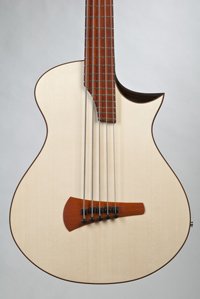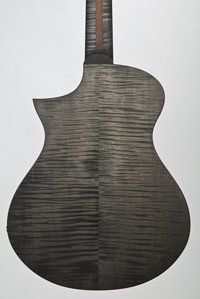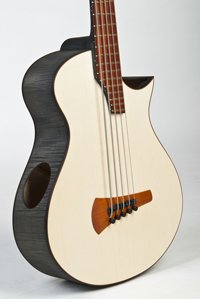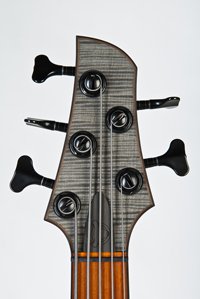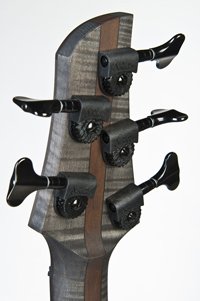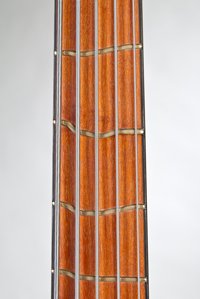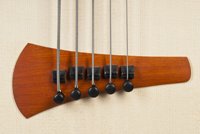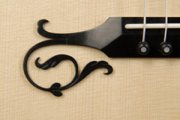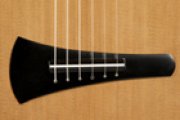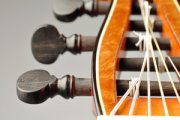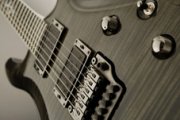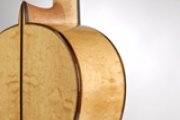True acoustic bass guitar
The prototype of a true acoustic bass guitar, pictured on the right, improves the resonance ability and the quality of the instrument’s sound radiation through specific innovation of construction and a sophisticated selection of materials. Due to these features the acoustic bass guitar can be used even unplugged as a fully adequate plucked instrument within an ensemble.
So far, acoustic bass guitars did only perform sufficiently when electronically amplified. For the use in an ensemble the bass guitars are equipped with piezoceramic sound pickups. A major drawback of this method is that the original sound of the instrument is falsified. Even big instrument making companies did not put much effort in the development of an instrument that can keep pace with other plucked instruments with regard to resonance ability and thus, the quality of sound radiation.
The True acoustic bass guitar is characterized by 5 constructive innovations compared to common acoustic bass guitars:
-
Due to the position of the soundhole at the side and in the “cut-away” (gap on the right side next to the fingerboard, which facilitates the playability of high positions) the whole soundboard remains a continuous entity. Compared with common ways of construction with the soundhole in the soundboard, the resonating surface of the soundboard is increased by 33%. This is important for the emission of fundamental bass notes. Moreover, the different positions of the soundholes allow for different directions of sound emission.
-
Completely innovative is the use of cut-aways for soundholes. The resulting slope optimizes the function of the cut-away considerably. The musician can reach the highest tones on the fingerboard more easily.
-
The common so called cross-bracing on the inside of the soundboard is substituted by an asymmetrical, radial bracing. The soundboard is the most important element for sound generation of a guitar. The radial bracing enables the soundboard depending on the excitation frequency to take on the optimal mode of vibration and thus, to emit a wide range of frequencies in a balanced way. Moreover, the vibration of the soundboard is less affected so that tones can be emitted more loudly. Nevertheless, the high string tension of 115 kg is statically caught.
-
The soundboard itself is made from the laminate of two very thin spruce plates (strength ca 1mm) with a middle layer made of aramid combs. This saves up to 25% of weight compared to the common use of massive spruce plates, but provides the same stiffness. The ability to resonate is significantly improved trough this innovation. The back of the instrument is not stiffened, but is also able to resonate so that it can resonate together with the soundboard. Due to this the cavity resonance, which is essential for a good bass transmission, is reached.
-
The concept of the bass reflex tube is adopted from the construction of Hi-fi speakers. A plastic pipe, which is positioned lowly at the instrument on a removable plate, supports the emission of very low tones. The resonating surface of an instrument of this size is theoretically too small for a fundamental emission of low frequencies. But the objective was to keep the instrument easy to handle regarding its size.
Inner construction
The constrictive modifications described in points 1, 2 and 4 were derived and developed further from the theories of the American physician Michael Kasha. Since 2004, I apply these modifications very successfully in my classical concert guitar model Kasha. For my acoustic bass I developed a new inner construction from these findings, which on the one hand considers the high enclosed string tension of a bass guitar, and on the other hand reacts like the soundboard of a concert guitar to a vibration. This influences important parameter, such as overtone spectrum, response, tone duration, and sound intensity positively.
The principle of the soundboard laminated with aramid combs (Point 3) was developed in 1990 by the German luthiers Matthias Daman and Gernot Wagner for the soundboards of their concert guitars. This so called double top construction is nowadays applied globally in the handcrafted guitar making. The dynamic range as well as the emitted acoustic energy is higher, according to the musicians, who play these instruments. It is the only innovation in guitar-making in the last 30 years, which prevailed successfully at the famous virtuosos (Manuel Barueco, David Russel, Scott Tennant).
Visual Appearance, Features, and Ergonomics
The shape of the instrument is an own design, which stands out in its elegance from the coarse shapes of other acoustic bass makers. The corpus, made from highest quality domestic flamed maple wood, is not bigger than the corpus of a common steel string guitar. This feature takes account of the increasing demand of ergonomic instruments and simplifies the daily handling of the instrument (e.g. transport).
In order to avoid the frequent top-heaviness of bass guitars, a special, lightweight machine head system from the German company Schaller is deployed. These machine heads are promoted as “The lightest bass-machine head in the world.”
A further improvement in ergonomics is achieved through the use of a so called “elevated fingerboard”. The fingerboard is not directly attached to the soundboard, but the neck is inserted into the corpus so that the fingerboard is situated elevated for some millimeters above the soundboard. The reachability of the highest tones is improved as well.
For the neck made from maple and Ipe (a wood used for bow making with excellent elasto-mechanic qualities), multiple plies of wood have been glued to increase the stability. Two absorber rods which are inlayed into the neck ensure a subsequent fine adjustment of the neck relief.
The scale length (the swinging string length) has the common length of 34 inch, i.e. 864mm. 24 frets are inlayed to the fingerboard made from Ipe wood with the “True Temperament” system. This system for binding comes from Sweden allows for an exact correction of intonation (see www. Truetemperament.com).
For the bridge ( tailpiece on the soundboard) also Ipe wood is used because of its ideal characteristics on the one hand and an artistic entity is formed through the limitation to only some complementary materials.
The decoration of the instrument dispenses with flamboyant ornaments. The soundholes, the fingerboard, the headstock, and the corpus are framed with ebony. Purflings made from Ipe wood as a binding for the soundboard take up the wood which was actually used for practical reasons. The exclusivity of the materials and handcrafted details, like the mitered bindings, underline the value of the instrument as a handcrafted product made by a master craftsman.
Awards
The design of the instrument on hand was awarded a special prize in the course of the 5th Upper Franconian Innovation Prize.
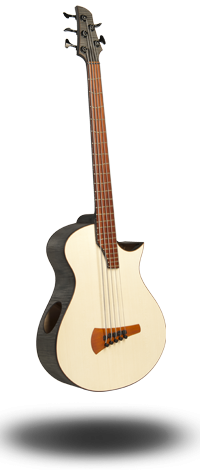
5-string acoustic bass guitar
